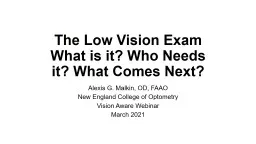

Alexis G Malkin OD FAAO New England College of Optometry Vision Aware Webinar March 2021 What is Low Vision Permanently impaired vision Vision loss that cannot be corrected by standard glasses surgery medications or contact lenses ID: 910391
Download Presentation The PPT/PDF document "The Low Vision Exam What is it? Who Need..." is the property of its rightful owner. Permission is granted to download and print the materials on this web site for personal, non-commercial use only, and to display it on your personal computer provided you do not modify the materials and that you retain all copyright notices contained in the materials. By downloading content from our website, you accept the terms of this agreement.
Slide1
The Low Vision ExamWhat is it? Who Needs it? What Comes Next?
Alexis G. Malkin, OD, FAAO
New England College of Optometry
Vision Aware Webinar
March 2021
Slide2What is Low Vision?Permanently impaired vision
Vision loss that cannot be corrected by standard glasses, surgery, medications, or contact lenses
No magic number to define “low vision”
Instrea
d based on how the person is
functioning
Most people with vision impairment have some usable vision
Slide3What is Vision Impairment?Visual Acuity
The letters the patient can see on the eye chart
High Contrast/Detailed Vision
Visual Function
How useful is the vision?
What tasks can the person perform with the vision that he has?
www.precision-vision.com
www.visionaware.org
Slide4What Causes Visual Impairment?Inherited eye diseasesAcquired conditions:
Cataracts
Macular Degeneration
Diabetes
Glaucoma
Trauma
Other damage to the visual system (i.e. stroke/TBI)
Slide5Overview of the Eye
www.nei.nih.gov
Slide6CataractsClouding of the lens inside the eye
Symptoms: fogging of vision, glare sensitivity, blurred vision
Usually treatable with surgery but not always
www.nei.nih.gov
Slide7Age-Related Macular Degeneration
Affects the central vision
More common as people get older
Usually affects both eyes but may start in one
Can be wet or dry
Caucasian>Asian>Black
Smoking is a big risk factor
Family history is a risk factor
Never leads to total blindness
www.nei.nih.gov
Slide8Diabetic RetinopathyCan cause central or peripheral vision loss
Fluctuations in vision are common with fluctuating blood sugar
New blood vessels grow leading to potential traction and retinal detachments
Swelling can occur distorting vision
Increased risk with increased time with diabetes
Increased risk with more poorly controlled BS
www.nei.nih.gov
Slide9Glaucoma
Group of diseases causing a progressive, irreversible optic neuropathy
Most cases are caused by open-angle glaucoma (structural definition)
Highest risk: age over 60, Black or Hispanic, family history
Starts with NO symptoms even when damage has already occurred
Leads to loss of peripheral vision first, then can cause total blindness
www.nei.nih.gov
Slide10What do the numbers mean?
20/20 “Normal”
20/40 Drive without restrictions
20/60 Read ordinary newsprint
20/70 Eligible for Medicare coverage of low vision rehabilitation services– i.e. home occupational therapy
Worse than 20/100 Eligible for blindness-related benefits
(legally blind)– i.e. transit services
Slide11Who is affected?Older adults (median age is 75)More women than men (68% female) present for low vision services
Prevalence increases dramatically after age 75 (data from 5 major studies)
Slide12How are people affected?Difficulty seeing detail/
reduced acuity
Difficulty with peripheral vision
Reduced contrast sensitivity
Slide13How are people affected? Activities
Driving
Reading
Activities of Daily Living
Cooking
Cleaning
Medication Management
General Seeing (i.e. seeing faces)
Mobility
Slide14How are people affected? Social EmotionalReduced independence
Increased rates of depression
Increased social isolation
Slide15What is Low Vision Rehabilitation?Terms vary across states, provinces and systemsHelps the person make the most of his/her remaining vision
Teaches Other Strategies to Achieve Goals
Helps Restore and Maintain Independence
Studies have shown that people who receive vision rehab services have a lower incidence of depression
Slide16What is Low Vision Rehabilitation? continuedLow Vision Examination including device assessment, glasses prescription and special testing (detailed visual fields, reading speed, scotoma identification)
Scotoma = central blind spot
Independent Living Skills
Orientation and Mobility Training
Connection to community resources (talking books, support groups)
Counseling/Patient Education
Slide17What is a Low Vision Exam?Eye and medical historyDetailed FUNCTIONAL history
Functional testing
Evaluation with low vision devices
Prescription of devices
Rarely insurers will cover the devices
LV providers can help you understand what is covered
Training / Patient Education
Referral for other services
NOT a Regular Eye Exam
www.visionaware.org
Slide18What are Low Vision Devices?
Specific to each person and to each goal
There is no “one size fits all” solution
Can include hand magnifiers (both optical and digital)
Computer technology
Telescopes
Binocular systems
Many others including optical character recognition (text to speech)
Talking BooksApps
www.visionaware.org
Slide19Do not be afraid to ask for help!Simple adaptations can make your life much easier
Start with “common sense” adaptations to your living environment
Examine your everyday environment carefully and make changes in your surroundings and activities that will help you feel safer, more comfortable, more organized, and more IN CONTROL – despite your vision loss.
Source: “Making Life More Livable,” edited by Maureen A. Duffy, M.S.
Slide20Basic Principles for those with Impaired VisionImprove Visibility – Contrast is key!
Get organized!
Use Other Senses
Use Labels
Safety First
Occupational Therapy and state blindness services can help
Source: “Making Life More Livable,” edited by Maureen A. Duffy, M.S.
Slide21How do I find a LV specialist?State Services or CNIB
VA Services
Large ophthalmology hospitals
Ask vendors/reps at senior center programs or health fairs
Local chapters of NFB/ACB in the US
Support Groups
Slide22General Community ResourcesNational Library Service/State Talking Books Library
NFB Newsline
CNIB in Canada
Lions Clubs
Slide23ConclusionsLow vision exams look at how you use your vision and provide recommendations to make daily life (work, home,
etc
) easier for you
There is a wide range of tools available to help visually and using other senses
Do not be afraid to ask for help/for a referral for low vision services if you are struggling with your vision